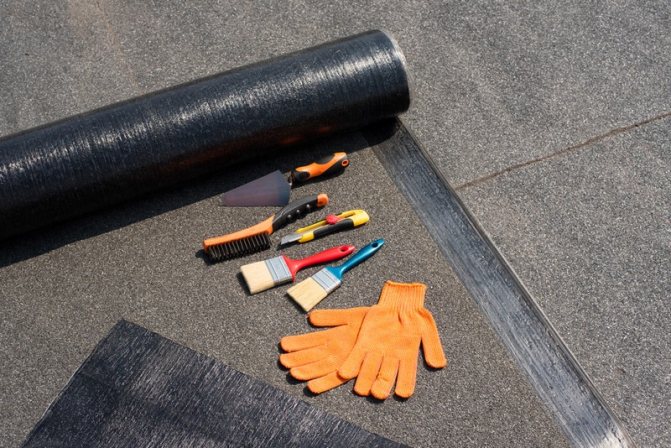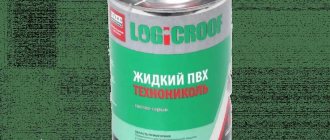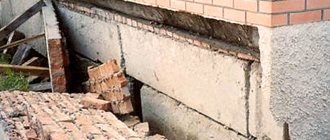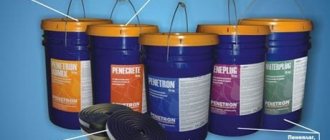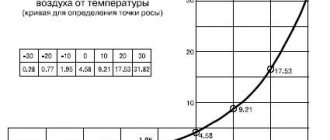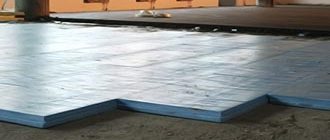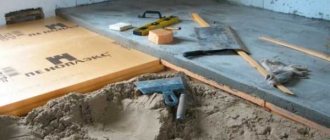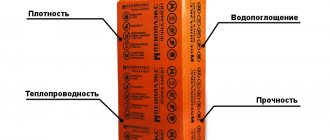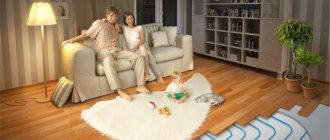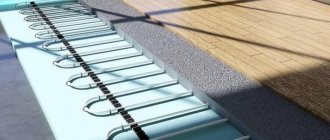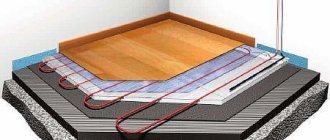Waterproofing the floor is necessary in order to isolate the bathroom or kitchen in case of a leak and not cause damage to the neighbors below. Unpleasant consequences can also affect other rooms, including the living room, bedroom or children's room. Considering the importance of this problem, the issue of installing a subfloor during a major or luxury renovation of an apartment should be approached in advance, since it will be quite difficult to correct the situation after completing the work on applying the finishing coating.
Waterproofing a bathroom floor can be done in two ways - pasting or coating. The first option, which involves the use of film waterproofing materials in rolls, is practically not used in repairs today, since it requires the use of complex execution techniques. This technique is especially not suitable for bathrooms with a raised threshold.
General principles for waterproofing basement floors
Protection against water penetration through the soil base of the floor is provided when there is close groundwater in the basement area.
But even with a deep horizon of aquifer, waterproofing is necessary for the basement, since when the snow melts and heavy rains, the water level rises significantly, the pressure increases, and moisture penetration through the capillaries of the soil base becomes possible. You need to know this: how to waterproof a basement from the inside.
The floor in the basement must be waterproofed.
If the groundwater level is higher than the basement floor level, waterproofing work is usually carried out during construction.
If the bottom of the basement is dry and the room itself is built in hard clay or rocky soil, then preparing the bottom of the pit for insulation work comes down to cleaning and leveling the base. In the case of wet soil, the principle of flooring is slightly different:
- The bottom of the dug pit (the floor of the future basement) is carefully cleared of crumbled and loose soil and compacted with mechanical or manual tampers.
- A layer of soft, pre-moistened fatty clay about 30 cm thick is placed on the bottom.
- The layer is leveled and compacted: this is a protective clay castle, or a natural layer of waterproofing, which is often enough to ensure dryness in the basement.
- Further steps to install a water barrier depend on the selected material, requirements for the basement and other factors.
In this video you will learn about basement waterproofing:
You have JavaScript disabled.
Hello!
Dear NormaCS, I would like to return to the discussion of this topic.
You write: “These are the conclusions of our experts.”
I will ask your experts to explain under what conditions in bathrooms “liquids flow periodically over the floor surface” (SP 29.13330.2011).
And if they do flow down, then where?
Further, SP 54.13330.2011: “9.20 The premises of the building must be protected from the penetration of rain, melt and ground water and possible domestic water leaks from engineering systems by structural means and technical devices.”
If you look at this point closely, then explain how the GI in the bathroom will protect against water leakage? The fact that it will not allow water to flow under the bathroom, but will allow it to leak in the living room? This is subject to prefabricated slabs. And in a monolithic ceiling (in the absence of holes), only in the area of technological holes.
Maybe this means overflow necks on sinks and bathtubs?
As a matter of principle, I do not consider emergency situations. In everyday life, leakage sensors will help here - they will shut off the water supply if the hose breaks. In case of a large and/or long-term flow of water, the GI will only save in combination with the ladder and ramp:
SP 29.13330.2011: “4.5 In rooms with medium and high intensity of exposure to liquids on the floor, floor slopes should be provided….
The direction of the slopes should ensure the drainage of wastewater into trays, channels and ladders without crossing driveways and passages.”
But for some reason your experts did not mention this point or deliberately “did not notice.”
Let's continue... The court case.
“... In addition, the sink in the washroom is in poor condition and water is leaking. ... the result was periodic flooding of the apartments below.”
This is what is causing the leak, not the pan itself.
Well, justifying the correctness of your arguments by the decision of the district court, which took your wording without any technical analysis... is simply not serious. This is not the Supreme Court! And I won’t say anything about the workload of district judges...
If we consider the structure of the bathroom, then look at how the assembled shower cabin is arranged: there are walls, a closing door, and a tray. There are no water leaks outside the cabin (again, we are not considering the possibility of an accident or malfunction of the shower cabin elements).
With normal and high-quality repairs, under the bathroom with a curtain on one side and a wall lined with plastic panels (I’m not talking about tiles at all) is always dry.
If the pallet is made without the use of finished products, for example from ceramic tiles on the floor, then of course in this case waterproofing is needed! But at the same time, a ladder or tray is provided in accordance with clause 4.5 of SP 29.13330.2011.
Best regards, sys81
Primer of the floor before waterproofing
Floor priming means impregnation of the base with compounds that prevent water from rising into the basement. To some extent, the clay castle performs the functions of priming, but traditionally it is the impregnation of the crushed stone-sand base of the floor with bitumen or mastics based on it. A number of polymer-based impregnating compositions are now produced, but for use in a private home, the traditional bitumen version will be cheaper and more practical. Works include:
- Laying a 5-10 cm thick sand layer on a clay base with leveling and compaction.
- The top is filled with fine crushed stone of a fraction of 5-10 mm, which is leveled and compacted tightly.
- Hot bitumen or mastic is poured over the crushed stone covering. Bitumen plays the role of a binder between stones, while simultaneously creating a film waterproofing coating.
- Further insulation work depends on the project and the wishes of the developer.
As a rule, such floor waterproofing is sufficient in a shallow basement of a garage or shed.
The device of a multilayer “pie”
If you pour bitumen mastic on the floors over a clay base, and then stick on roofing felt, roofing felt, waterproofing or other protective material, then such a coating will be external, it will be the first to stand in the way of water. Depending on the pressure of the aquifer, such coverage may not be sufficient. Therefore, concrete coverings and, if necessary, additional insulating layers are placed on top in various variations.
This is interesting: how to waterproof a basement against groundwater.
A more reliable option for all types of basements can be considered the construction of a multi-layer “pie” of:
- preparatory crushed stone-sand lower layers;
- concrete coverings;
- mortar screeds;
- water-repellent substances in concrete or mortar mixtures;
- waterproofing roll and coating layers.
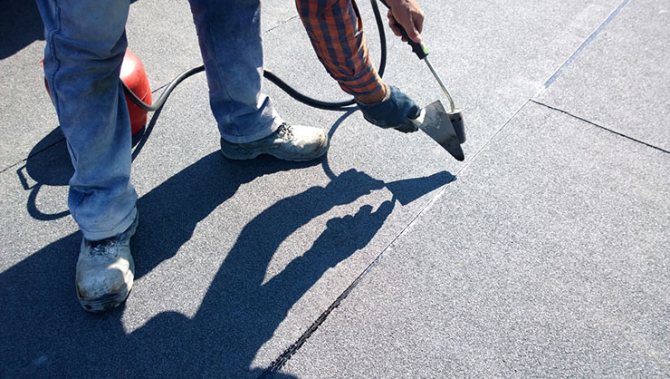
The number and thickness of individual layers of such anti-pressure waterproofing of basement floors depend on:
- proximity to groundwater;
- purpose of the basement, operation options;
- the presence or absence of protection from water in the walls of the structure;
- soil categories of the basement location;
- climatic conditions.
As the best option for most basement floors, we can recommend a simple and not very expensive option for multi-layer protection of the floor in the basement, which is understandable and can be done with your own hands.
The layers of the “pie” are made on a leveled and compacted clay base:
- The surface is covered with a concrete mixture 5-7 cm thick, you can use low grade lean concrete.
- The mixture is leveled and compacted. For compaction, you can use a piece of log about 30 cm in diameter with a strip nailed on top in the center for easy lifting.
- After 7-10 days, after the mixture has hardened and dried, the surface is covered with a continuous layer of bitumen mastic. For leveling, it is convenient to use a device in the form of a regular mop.
- A carpet made of inexpensive rolled insulating material, roofing felt or roofing felt is rolled out and pressed tightly on top of the bitumen.
- The procedure of spreading bitumen is repeated, but on the first layer of insulating coating.
- The first layer of roofing material is laid with an overlap of at least 15 cm. The top coating is made perpendicular to the bottom with the same overlap.
- Next, a layer of concrete mixture is laid on top in the same way as the underlying concrete layer.
- The last top covering can be a cement-sand screed with surface reinforcement with dry cement. Alternatively, the final floors can be constructed from wild flat stone or inexpensive floor tiles.
- The walls of the basement are erected directly on the top floor covering.
One of the inexpensive but extremely effective methods of waterproofing can be considered the preparation of a concrete mixture using liquid glass. Everyone is familiar with the material: it is silicate office glue with a thinner consistency. By reacting with cement, liquid glass creates a monolithic waterproof layer. This method was recently used to construct concrete water tanks and protect swimming pools.
Penetrating waterproofing
Modern technologies offer a number of compounds for waterproofing basements that penetrate concrete or other layers; Penetron can be considered one of the main ones.
The composition is used in basements with close groundwater levels and loose porous soils.
Preparation
Treatment of concrete surfaces of basement floors with Penetron is carried out only after a series of preparatory operations. They must ensure maximum penetration of the insulating composition into the concrete structure. An obstacle to saturating concrete with insulating impregnation is usually the finishing or insulating layers on top of the main concrete floor covering:
- lime plaster;
- painting and finishing layers;
- accumulation of dust, pollution; film insulating coatings;
- moisture protection that does not perform its functions well.
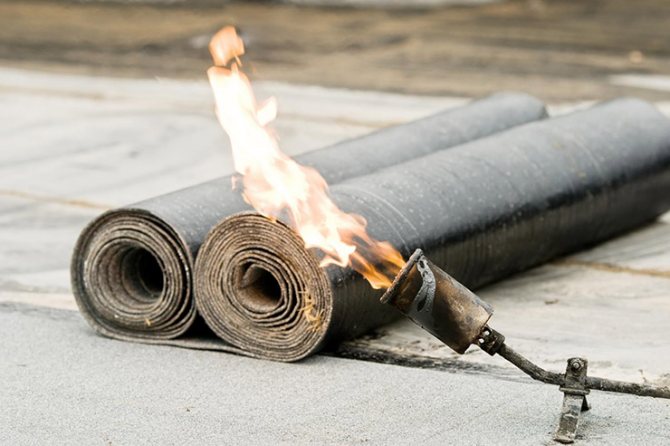
The task of the preparatory process is maximum cleaning of foreign materials unusual for concrete and ensuring access of penetrating insulation into all pores and capillaries of the concrete covering of the basement floor.
Removal of the listed layers can be done mechanically by hand, but to achieve the greatest effect from using the composition, the surface should be polished with special devices with abrasive materials. In some cases, it is possible to use cleaners and compounds like “Lepta Himfrez”.
The final stage of cleaning is the removal of dust and wetting the surface under pressure until the concrete is completely saturated with water using Kärcher devices.
Composition application technology
The process of applying a waterproofing agent to a concrete surface can be done independently, but be sure to use chemical-resistant rubber gloves:
- dry mixture “Penetron” is diluted at the rate of 400 ml of water per 1 kg of mixture;
- the consistency after mixing must correspond to the definition of a “jelly-like” liquid;
- apply the first continuous layer with a wide brush;
- the second time the concrete is coated after the first layer has dried at intervals of about an hour;
- from drying out, the coating is moistened within a week using a watering hose with a spray nozzle;
- If additional protection against overdrying is required, various film materials can be used.
Waterproofing basement floors with Penetron and identical compounds can be done independently, but the process is quite labor-intensive, dirty and unsafe for health. Invited specialists perform such work at a price of 300 to 500 rubles. for 1 m2.
The market offers a large selection of waterproofing compounds of similar action: “Hydrohit”, “Kalmatron”, “Maxill” and others.
Basic flooring base
If the surface of reinforced concrete floors has differences in height, coarse levelers are used. For delicate coatings, the base is made of two components - a cement screed and a self-leveling floor.
In order to obtain the most even surface possible, self-leveling mixtures with a more liquid consistency can be used. Compositions of this type are excellent for carrying out express repairs in a toilet or bathroom, since in this case it only takes a couple of days to complete all the necessary work.
One of the most difficult foundations is a floating floor, the task of which is to increase sound and heat insulation. Its installation is carried out using a complex technology, which involves the application of three layers - mineral wool boards, polyethylene film and a special self-leveling solution.
Waterproofing with coating materials
In addition to traditional bitumen mastics, there are many different materials and technologies to protect against moisture entering the basement. They can be instantaneous, creating, as it were, plugs in the cracks of the protective layers - these are injection types of waterproofing, they are more relevant for protecting basement walls.
Can be used as a backup protective inner layer if there is external protection. Pasting and coating materials can be used inside and outside the protected structure. Some types of insulation have decorative properties.
Hardening and creation of a durable waterproofing coating for all materials varies in terms of timing, thickness and operating parameters.
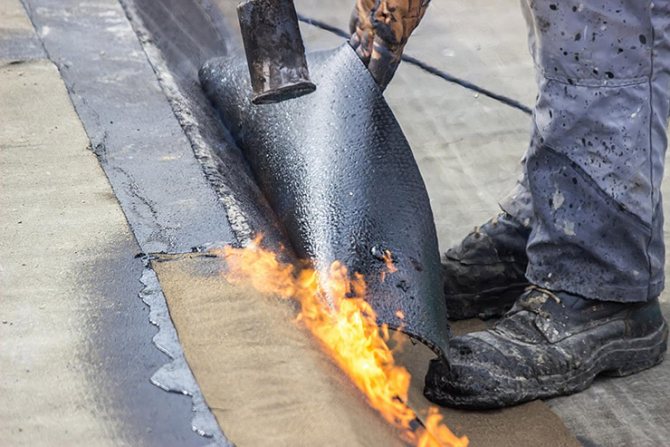
Coating materials have a number of nuances
Cold curing mastics
For waterproofing existing concrete floors, polyurethane and polycarbamide mastics, produced in one- or two-component form, can be used.
Polyurethane mastic is characterized by:
- hardening occurs a few seconds after application;
- has high mechanical strength;
- forms an elastic and chemical-resistant coating;
- It is usually produced in a one-component version.
Polyurea or polyurea waterproofing is a combination of epoxy resin and polyurethane. In the basement it can be used not only to protect floors and walls from water. It hardens quickly, has high mechanical strength, and has an excellent decorative appearance.
Specific gravity of waterproofing
Waterproofing materials make up a relatively small percentage of the total weight of the structure, but their weight should also be taken into account. Let's consider the main and most popular types of materials, what features this or that waterproofing , volumetric weight and specific gravity indicators.
Comparative table of average weight values of various types of waterproofing
| Type of material | Coating weight per 1m2 (g) 1 layer |
| Bitumen | 1000 – 3000 |
| Ruberoid | 500 — 1700 |
| Films | 92 – 132 |
| Bentonite mats | 4000 – 6000 |
Coating waterproofing
It is a variety of mastics used outside foundations, joints of block walls, roofs, for treatment inside basements, bathrooms. These are bitumen-containing substances with a relatively short service life and a short cyclic freezing period.
Polymer-bitumen mastics are also unstable to mechanical damage; without freezing, they will last no more than 6–7 years without freezing.
According to calculations, the weight of waterproofing 1 m2 of bitumen-polymer mastic is in the range of 1 - 5.5 kg, depending on the base material, place of application and layer thickness.
Pasted waterproofing
This type includes the usual roofing felt and various bitumen-containing materials based on fiberglass, polyester, etc. They are laid on a variety of bases for waterproofing roofs and foundations. Recommended use in combination with additional means.
An example is roofing felt. The weight of the waterproofing in this case will be on average 1700 kg/m3.
Film waterproofing
It is used when installing roofs and constructing baths and is a single- or multi-layer membrane with additional coatings. Reflective vapor-waterproofing with a density of 92 to 132 g/m2 is considered waterproof.
The pores of the membranes allow surfaces to “breathe” and create an optimal indoor microclimate. Over time, pore conductivity may decrease. You cannot use such materials under euro slate and metal tiles.
Liquid rubber
Nowadays, the material in demand by consumers is for basement waterproofing, which is produced by the manufacturer in finished form, has many brand names, but is united by a common name - liquid rubber.
Easy to work with:
- The floor surface is cleaned and dried.
- The contents of the purchased container are thoroughly mixed, preferably using a mixer or a drill attachment.
- Apply with a brush or roller to the surface.
- The mastic will penetrate into all pores and cracks; in case of significant unevenness, they will be filled and leveled, but this leads to excess consumption of material.
- After drying, the layer resembles a rubber coating.
From the point of view of feasibility and costs, it is worth paying more attention to traditional methods of installing waterproofing coatings.
For example, installing clay preparation for floors 20-40 cm thick will cost the developer the minimum possible amount, but will exceed the efficiency of many modern waterproofing materials.
Stages of work
Waterproofing a bathroom when renovating a cottage or apartment includes several successive steps:
- Strengthening the corners between the floor and the wall.
- Treatment of joints using waterproofing mastic.
- Gluing corners by drowning their edges in the solution.
- Fastening the reinforcing tape, which requires preliminary installation of special cuffs on the pipe openings.
- Apply mastic to the surface of the walls in two layers, with an intermediate drying time of at least three hours.
- Leveling the waterproofing layers using a roller or steel trowel.
